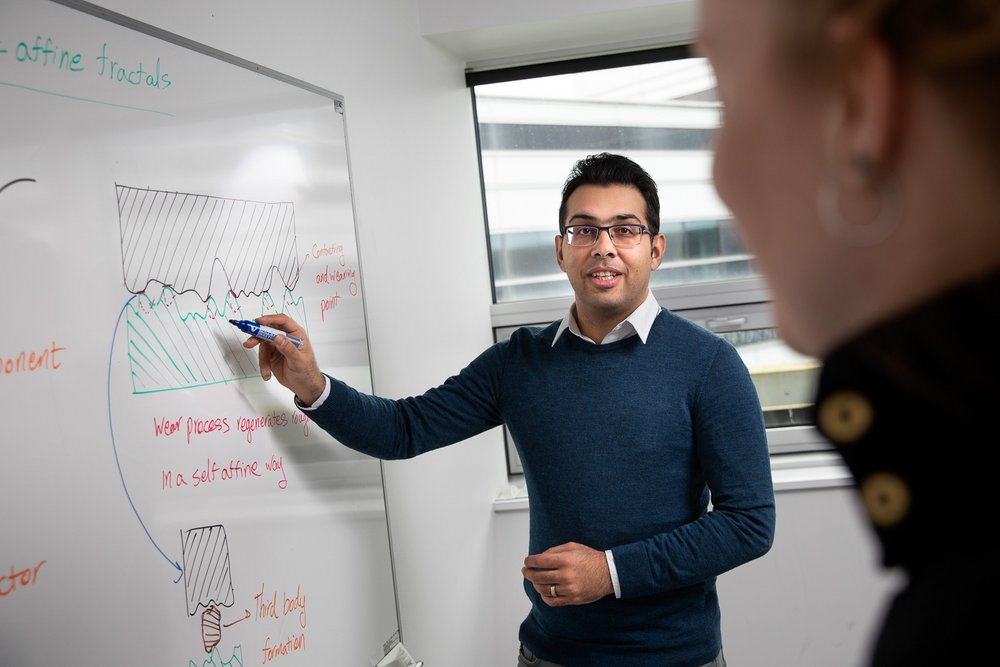A new first: Scientists mimic Nature’s self-affinity using computer simulations
For the first time ever, researchers have simulated the process of surface roughness creation: a step forward in understanding the emergence of fractal characteristic of rough surfaces on many scales ranging from atomic to geological scales – and maybe a step forward in earthquake prediction.

The topography of the world looks the same whether you look at it from a hilltop viewpoint or under the eyes of a microscope. A mountain range at geological scale is rather identical to the roughness features of an otherwise solid metal object at nanometer scale. This similarity has first been highlighted in 1983 by mathematician Benoit Mandelbrot.
Since then it has been proven that all fractured surfaces share a similar characteristic, referred to as fractal self-affinity. This unique characteristic is often attributed to the physics of crack propagation through solid materials which - up until now - has proved notoriously difficult to model.
"This is the first time we have been able to reproduce self-affinity of sliding surfaces using computer simulations. Our simulations clearly illustrate how subsurface crack propagation and surface wear generates near-identical roughness across multiple scales, independent of initial roughness state," says Ramin Aghababaei, Assistant Professor at the Department of Engineering, Aarhus University.
The study shows that the development of the self-affine morphology is due to smoothing and re-roughening mechanisms via subsurface crack propagation and third body configuration, and the new findings have been published in Nature Communications.
The numerical technique, which was the stepping stone for this work, was developed by Ramin Aghababaei in collaboration with scientists from École Polytechnique Fédérale de Lausanne (EPFL), Switzerland and Cornell University, USA.
(The article continues below the picture)

Assistant Professor Ramin Aghababaei is of the opinion, that his research might also be utilized in earthquake detection. Photo: Lars Kruse / AU Foto.
"I started to work on this subject three years ago when I was at the EPFL and worked in the Computational Solid Mechanics Laboratory of Prof. Jean-Francois Molinari. The current study was made possible by the great effort of PhD student, Enrico Milanese, lead author of the paper, who used the developed technique and conducted large scale simulations to track the roughness evolution of surfaces sliding against one another," Assistant Professor Aghababaei explains.
The main goal of the current project was to model the process of roughness creation, but the perspectives of their findings are far reaching. Controlling surface roughness is essential to the performance and durability of virtually all engineering applications. For instance, this is of great interest for manufacturing industries to predict and control the surface finish of machined components according to target tolerances.
"In this study, we investigated the mechanism of roughness creation, and we propose it has to do with subsurface crack propagation and material removal at different scales. A crack never goes straight. It twists and curls like a lightning bolt that curves through the air. And when you zoom in, that same waviness self-replicates on smaller scales. In other words, the crack propagation pathway dictates the self-affine nature of rough surfaces at all scales," Ramin Aghababaei says and couples it to the natural fault roughness at the geological scale.
"Mankind still don’t know why earthquakes happen, but we believe it’s a matter of microscopic crack propagation at the subsurface of the earth, sending out seismic waves that make the ground shake. And if we can understand the crack initiating mechanism by post-factum analyzing of faults roughness, we hope we can predict something," he adds.
Ramin Aghababaei, who’s leading the Surface Mechanics Group at the Department of Engineering, Aarhus University, is currently collaborating with geologists to use this knowledge to understand the microscopic origins of earthquakes.
"I am really proud of this work and a great collaboration with the EPFL team on this project. I believe this new technique opens many new possibilities to explore micromechanics of surface degradation and failure, to lay a theoretical foundation for developing the next generation of wear-resistance materials and coatings, hoping to reduce the material wastage due to wear," he says.
Notes
The first study using the numerical technique was previously published in Nature Communications where the group disclosed a material length scale that controls surface material removal mechanisms: www.nature.com/articles/ncomms11816
Contact
Ramin Aghababaei
Assistant Professor, Aarhus University
Mail: aghababaei@eng.au.dk
Phone.: +45 93508956
